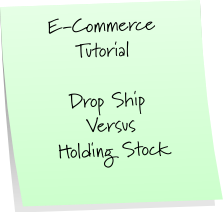I was recently asked by a soon-to-be online shop owner about the advantages and disadvantages of using drop shipping versus holding stock.
Advantages of ‘Drop Ship’
Drop Ship means the retailer doesn’t hold the items in stock in their warehouse. When the orders come in, the retailer contacts the supplier who despatches the items ordered.
- Much less investment is required.
- You can offer many more items for sale – have much more variety of product on your online store.
- Money isn’t tied up in stock.
- Storage for stock isn’t required.
- You only pay the supplier when the order comes in.
- Much less risk when starting an online business
- Makes managing cashlow much easier.
- You don’t have to spend time packaging up the orders.
- You don’t have to spend money on packaging.
- You don’t have to sell items as a reduced cost.
- You can start to promote and sell the products once you upload them to the website, you don’t have to wait for them to arrive.
Disadvantages of Drop Shipping
- The margins may be much less as suppliers may not allow as low as a wholesale price as they might with one large order. You will have the expense of the advertising, google adwords, time spent on social media and payemnt card fees not to mention free shipping if you provide it (Many online stores offer free shipping over a certain spend).
- You must ensure that your suppliers are reliable and will send out the product as promptly as promised. You are the business responsible if things go wrong (in the eyes of the consumer).
- Some companies do not offer drop shipping so if you want to stock their products, you have to hold their stock.
Advantages of Holding Stock / Inventory Management
- You can have stock of products from new designers abroad who may give you exclusivity on them for your country. This can generate considerable interest as well as significant press coverage for the products and your business.
- You know your stock levels and you aren’t relying on a supplier.
- Your products may be more ‘exclusive’, unusual and niche compared to suppliers who offer drop ship and facilitate many online stores.
Disadvantages of Holding Stock/ Inventory Management
- You have money tied up in stock.
- You require a warehouse (or a spare bedroom or garage) for storing the stock.
- For first orders with a new supplier, it will be on ‘proforma’ which means you have to pay for the order before they despatch it. This means that you might have paid for it a few weeks before the order arrives and orders come in.
- You have to pack and despatch each order. This can take significantly more time than you might expect.
- If some products prove to be unpopular, you may have to sell them at a price that is lower than the wholesale price.
- You have to do regular inventories of your stock.
- There is a risk of stock becoming damaged or stolen.
- Return on investment can take a long time.
My Experiences as an Online Retailer
I have used a mixture of drop ship and holding stock in my online store at Garrendenny Lane. I also worked on a ‘sale or return’ with some designers e.g. I would hold some of their products in stock and pay them when they sold (at the end of each month). If something was ordered that I didn’t have in stock, they would despatch it. The disadvantage of this was if the order was for multiple items of which I would despatch most and the other item was drop shipped, hence the online shop has to swallow the cost of the extra shipping.
With some designers, I held stock of their most popular items and they would ‘drop ship’ if an order came in for a new or less popular product and this worked very well. I also sold wallpaper on a ‘drop ship’ basis but the margins on these were very slim with some suppliers.
There are many online stores now selling a wide variety of products from various designers or companies. The disadvantages for them are that customers will have to pay a separate shipping fee for each supplier which may put them off. There is also the risk that customers may purchase directly from the supplier rather than the website that invested more in PR and advertising.
Another quick tip for online stores – check out the photography of each supplier before you place an order unless you are prepared to spend significant time taking your own photos. If they have good quality high resolution cut-out and lifestyle images that you can use on your own website and use to get PR, it is a huge plus in my opinion.
I’ve used my own experiences to answer the question of Drop Ship v Inventory Management- do you have any comments to add from your own experiences?









